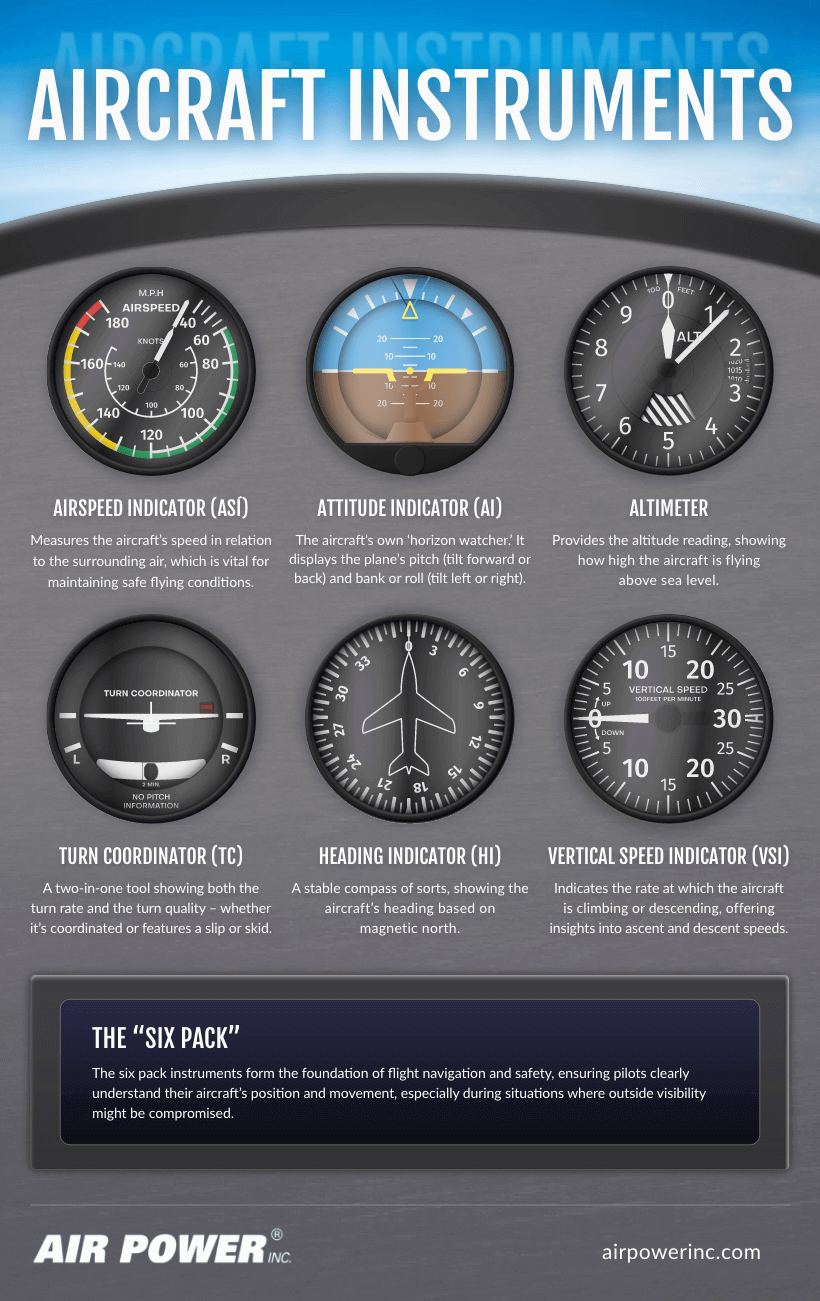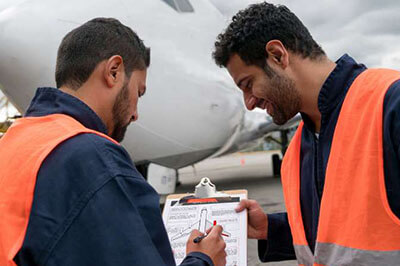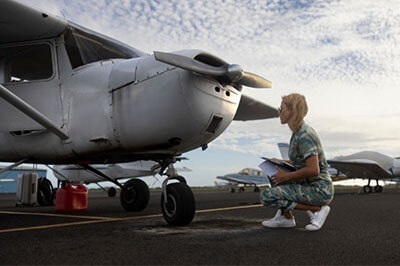Navigating the skies requires a deep understanding of the aviation six pack, the essential instruments that empower pilots with vital flight data. This article delves into the intricacies of these instruments and their real-world applications.

Let's talk about something every pilot can agree on: the importance of the six pack aviation instruments. Every seasoned aviator and rookie pilot will recognize this cluster's essential nature. Every time a pilot takes to the skies, the six pack airplane instruments take center stage, ensuring the safety and accuracy of every flight maneuver.
The six pack flight instruments are the eyes and ears of a pilot, providing crucial data that helps navigate the ever-changing conditions of the skies. From gauging altitude to deciphering orientation, the six pack instruments are indispensable tools that pilots rely on during every phase of their journey.
In this article, we'll take an in-depth look at each of the six pack aviation instruments, unraveling their significance and offering insights into their operation. Whether you're an aspiring pilot or a seasoned veteran, understanding and mastering the aviation six pack is key to safer, better flights.
What Is the Six Pack in Aviation?
At the heart of every cockpit lies a standard set of main instruments to provide pilots with current information on aircraft speed, altitude, climb/descent, attitude, heading and turning/banking. These aircraft instruments are informally referred to as the six pack in aviation:
- Airspeed Indicator (ASI)
- Attitude Indicator (AI)
- Altimeter
- Turn Coordinator (TC)
- Heading Indicator (HI)
- Vertical Speed Indicator (VSI)

- Airspeed Indicator (ASI): Measures the aircraft's speed in relation to the surrounding air, which is vital for maintaining safe flying conditions.
- Attitude Indicator (AI): The aircraft's own 'horizon watcher.' It displays the plane's pitch (tilt forward or back) and bank or roll (tilt left or right).
- Altimeter: Provides the altitude reading, showing how high the aircraft is flying above sea level.
- Turn Coordinator (TC): A two-in-one tool showing both the turn rate and the turn quality – whether it's coordinated or features a slip or skid.
- Heading Indicator (HI): A stable compass of sorts, showing the aircraft's heading based on magnetic north.
- Vertical Speed Indicator (VSI): Indicates the rate at which the aircraft is climbing or descending, offering insights into ascent and descent speeds.
The "Six Pack"
The six pack instruments form the foundation of flight navigation and safety, ensuring pilots clearly understand their aircraft's position and movement, especially during situations where outside visibility might be compromised.

Aviation Six Pack Instruments Explained
Companies who design and manufacture the six pack flight instruments, like Alcor Precision Parts, divide them into two categories based on their operating principles: Pitot-Static and Gyroscopic.
The pitot-static instruments (Airspeed Indicator, Altimeter, Vertical Speed Indicator) draw information from the aircraft's static and dynamic air pressures, whereas the gyroscopic instruments (Attitude Indicator, Heading Indicator, Turn Coordinator) rely on spinning gyroscopes to determine the aircraft's orientation and direction.
1. Airspeed Indicator
The airspeed indicator, a primary pitot-static instrument, measures how fast the aircraft is moving through the air. It compares the ram air pressure (from the pitot tube) and the static air pressure (from the static port). The difference between these pressures gives the dynamic pressure corresponding to the aircraft's speed. Several critical speeds are color-coded on ASIs, including stall speeds and maximum allowable speeds, ensuring pilots operate within safe parameters.
Green signifies the normal operating range. White indicates the flap operating range (when flaps can be utilized safely.) Yellow is the caution range. The red line shows the maximum speed that should not be exceeded.
2. Attitude Indicator
Also known as an artificial horizon, the attitude indicator is a gyroscopic instrument. It provides a visual representation of the aircraft's orientation relative to Earth's horizon. The AI displays two primary movements: pitch (nose up or down) and bank or roll (tilt left or right). Inside, a gyroscope spins rapidly and maintains its orientation, allowing the instrument to display the aircraft's attitude even if external visual references are lost, such as in cloudy conditions or at night.
3. Altimeter
Another critical pitot-static instrument, the altimeter, indicates the aircraft's altitude above mean sea level (AMSL). It measures static air pressure from the static port and converts it into a height reading. As atmospheric pressure decreases with altitude, the altimeter can interpret these changes and display them as altitude variations. Three pointers provide the altitude information in 100, 1,000 and 10,000 foot increments. Pilots must set their altimeters to the local barometric pressure to ensure accurate readings, especially during approaches and landings.
4. Turn Coordinator
The turn coordinator is a combination of gyroscopic functionalities. It consists of two parts: a turn indicator and an inclinometer. The turn indicator reflects the rate of the aircraft's yawing motion (turning left or right). The inclinometer, filled with liquid and featuring a black ball, indicates the quality of the turn – whether it's coordinated or there's a slip or skid. Together, they offer a comprehensive look at the aircraft's turning performance.
5. Heading Indicator
A gyroscopic instrument, the heading indicator (sometimes called the Directional Gyro or DG), displays the aircraft's direction relative to magnetic north. Unlike a simple magnetic compass, the HI remains stable during flight maneuvers and is unaffected by most pitch and bank changes. However, it's subject to gyroscopic drift and precession, so pilots periodically adjust it using the magnetic compass as a reference.
6. Vertical Speed Indicator
Part of the pitot-static system, the vertical speed Indicator showcases how quickly the aircraft ascends or descends. It measures the rate of change in static air pressure, translating it into feet per minute (fpm). This provides real-time feedback to the pilot about the altitude change rate, which is crucial during climbs, descents and level flight.
See the Aviation Six Pack In Flight
Want a better look at how the aviation six pack functions in flight? Check out this short video showcasing the six pack instruments operating in a Cessna 172 flight simulator.
Understanding the Importance of the Six Pack in Aviation
In the unpredictable world of aviation, six pack airplane instruments prove their worth daily. Here are a few potential real-world scenarios that underscore the critical role these instruments play:
- Flying in IMC (Instrument Meteorological Conditions): When visual environmental cues are lost due to clouds, fog or night flying, the attitude indicator becomes vital. It allows pilots to maintain proper orientation and prevent spatial disorientation – a leading cause of accidents in such conditions.
- Approaching a Mountainous Airport: The altimeter and vertical speed indicator are indispensable when approaching an airport in the mountains. An accurate altitude reading ensures that the aircraft maintains a safe elevation above ground level, while the VSI helps manage ascent or descent rates to avoid terrain.
- Navigating Through Busy Airspace: Knowing your precise heading is crucial in congested airspace, especially near major airports. The heading indicator aids pilots in maintaining specific routes or vectors given by air traffic controllers, ensuring safe distances between aircraft.
- Handling Engine Failures in Multi-Engine Aircraft: Maintaining coordinated flight is crucial to avoid a dangerous yawing motion if an engine fails in a multi-engine plane. Here, the turn coordinator comes into play, assisting pilots in making balanced turns and keeping the aircraft under control.
- Landing in Crosswind Conditions: Understanding the speed and approach angle during landings, especially in crosswinds, can be the difference between a smooth landing and a runway excursion. The airspeed and attitude indicators collectively provide pilots with data to make necessary adjustments, ensuring safe touchdowns.
In each of these scenarios, the aviation six pack doesn't just provide data – it offers a lifeline, allowing pilots to make informed decisions under pressure.
Frequently Asked Question: Six Pack Aviation Instruments
If you still have questions or would like to learn more about the six pack aviation instruments, check out the answers to our most frequently asked questions below.
Which Six Pack Instruments Need Electricity?
The attitude and heading indicators of the traditional six-pack flight instruments require electricity for their gyroscopes.
The rest of the instruments in the six pack primarily rely on either the pitot-static system or are mechanically driven and do not need electricity for their basic operation. However, modern digital avionics displays, which might replace these traditional instruments, require electrical power.
When Did the Aviation Six Pack Become Standard?
The aviation six pack was first identified in 1937 by Britain's Royal Air Force, after which it became standard in all their aircraft. As aviation technology advanced and the need for standardized training and instrument layouts became apparent, the six pack arrangement was widely adopted worldwide after WWII for its efficiency and ease of use, especially in general aviation aircraft.
Do All Aircraft Have a Traditional Aviation Six Pack Layout?
While the aviation six pack became standard in many aircraft, modern aircraft, especially those with glass cockpits, may display this information digitally on screens. The data is the same, but the presentation can differ.
Shop Six Pack Aviation Instruments at Air Power Inc.
Navigating the skies demands precision, trust and top-tier equipment. Throughout this article, we've explored the indispensable role of the six pack aviation instruments – a suite of instruments that pilots worldwide rely upon. As your journey in aviation continues, ensure your cockpit is equipped with the best. Air Power Inc., a trusted name since 1992, is your one-stop-shop for six pack flight instruments. We proudly carry top-rated brands like Alcor Precision Instruments and more, ensuring you receive unmatched quality and performance. Choose Air Power Inc., and fly with the assurance that you have the industry's best at your fingertips.
Shop Six Pack Instruments
Related Articles: The Six Pack In Aviation



